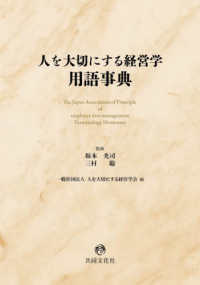- ホーム
- > 洋書
- > 英文書
- > History / World
Full Description
In Craftsmen and Jewelers in the Middle and Lower Danube Region (6th to 7th Centuries) Daniela Tănase examines the practice of metalworking with the aim of comparing the archaeological evidence of different peoples in the Middle and Lower Danube in the Early Middle Ages, with a particular focus on blacksmithing, goldsmithing and burial customs. Evidence suggests that the distinction between these specialties was quite fluid, so blacksmiths could craft jewelery, while jewelers were able to create tools and weapons. The study also reveals how the production process and the main techniques employed by craftsmen for the ornamentation of dress and accessories were subject to multiple influences, from Byzantium, the eastern steppe, and the Merovingian kingdoms.
Contents
Contents
Acknowledgements
List of Figures
Introduction
1 History of the Research
1 Discovery of the First Tombs with Tools
2 The History of Research regarding Burials with Tools (First Half of the 20th Century)
3 The Status of Early Medieval Craftsmen in European Historiography
4 Graves with Tools in Early Medieval Europe. The Case of the Avar Qaganate
5 Tools in Assemblages of the Forest-Steppe Belt of Eastern Europe
6 Early Medieval Metalworking in the Literature Published in Romania after World War II
2 The Archaeology of Metalworking
1 Workshops
2 Graves
3 Hoards
4 Isolated (Stray) Finds
5 Workshops or Funerary Contexts - an Indicator of a Different Cultural Behavior
3 Sources of Raw Materials
1 Extraction and Reduction of Iron Ore
2 Alloys
3 Precious Metals
4 Trade as a Possible Source of Raw Material
4 Metallurgical Technologies
1 Metalworking Techniques
2 Techniques of Non-Ferrous Metallurgy
5 Special Technological Methods for the Manufacture of Clothing and Harness Accessories Made of Non-Ferrous Metals
1 Pressing on Dies
2 Casting in Molds and Casting by the "Lost Wax" Method
3 Granulation and Filigree
4 Silver and Niello Inlaying
5 Gilding
6 Stones and Glass Inserts
6 The Tools
1 Pliers
2 Hammers
3 Anvils
4 Drills
5 Wire-Drawing Plate (or Nail-Making Tool)
6 Tools for Making Nails and Rivets
7 Files
8 Engraving Tools
9 Chisels
10 Punches
11 Mandrels
12 Tweezers
13 Bone Dies
14 Metal Patterns
15 Ladles
16 Crucibles
17 Clay Molds
18 Stone Molds
7 The Ornamentation of the Dies and of Contemporaneous Dress Accessories
1 Ornamental Styles and Motifs of Byzantine Origin
2 Ornamental Styles and Decorative Motifs of Germanic Origin
3 Animal Style II with Dentil Ornamentation
4 Ornamental Styles and Motifs from the Forest-Steppe Zone of Eastern Europe
8 The Cultural and Chronological Framework of the Tool Finds
1 Graves with Tools
2 Settlements
3 The Issue of Ethnicity
9 Metalworking Craft and the Social Status of Blacksmiths and Goldsmiths
1 Metalworking and the Craftsmen's Way of Life
2 Craftsmen's Mobility
3 Sketching Regional Styles - a Traveling Sign?
4 Who Were the Craftsmen?
10 Conclusions
11 Catalogue of Finds from Romania
1 Aldeni (Buzău Co.) (Fig. 42.1)
2 Banat? (Fig. 42.2a-c)
3 Band/Bandu de Câmpie/Mezőbánd/Bandorf (Mureș Co.) (Fig. 31-36)
4 Băleni-Români (Dâmbovița Co.) (Fig. 12.1)
5 Botoșana (Suceava Co.) (Fig. 12.2-4, Fig. 17)
6 Bratei/Pretau/Baráthely (Sibiu Co.) (Fig. 3)
7 Bucharest
8 Budureasca, Vadu Săpat Village, Fântânele Commune (Prahova Co.)
9 Cacica/Kaczyka (Suceava Co.) (Fig. 5.3)
10 Cândești (Buzău Co.)
11 Coroteni, Slobozia Bradului Com. (Vrancea Co.) (Fig. 5.4)
12 Corund/Korond (Harghita Co.) (Fig. 5.2.1-2)
13 Costești, Town of Târgu Frumos (Iași Co.) (Fig. 44.1, Fig. 45)
14 Cristuru Secuiesc/Székelykeresztúr/Kreuz (Harghita Co.) (Fig. 5.1)
15 Cucuteni (Iași Co.) (Fig. 5.5)
16 Davideni, Țibucani Com. (Neamț Co.) (Fig. 20-22)
17 Dichiseni (Călărași Co.) (Fig. 44.2a-b)
18 Dodești, Viișoara Com. (Vaslui Co.) (Fig. 15-16)
19 Dolheștii Mari, Dolhești Com. (Suceava Co.) (Fig. 44.3)
20 Dulceanca (Teleorman Co.) (Fig. 14)
21 Dumbrăveni/Elisabethstadt/Erzsébetváros (Sibiu Co.) (Fig. 37.1)
22 Felnac/Fönlak (Arad Co.) (Fig. 37.2.1-10-41)
23 Giurcani, Găgești Com. (Vaslui Co.) (Fig. 7.2)
24 Govora, Mihăiești Com. (Vâlcea Co.) (Fig. 7.1)
25 Gropșani (Dolj Co.) (Fig. 7.4)
26 Izvoare-Bahna (Neamț Co.) (Fig. 7.5)
27 Izvorul Dulce, Merei Com. (Buzău Co.) (Fig. 7.3)
28 Lazuri/Lázári/Neuschlag (Satu Mare Co.) (Fig. 4)
29 Lozna, Dersca Com. (Botoșani Co.) (Fig. 24-29)
30 Morești/Malomfalva/Mühlendorf, Ungheni Com. (Mureș Co.) (Fig. 2.1)
31 Moțca (Iași Co.) (Fig. 2.2)
32 Olteni, Dobrogostea Village, Olteni Com. (Teleorman Co.) (Fig. 2.3)
33 Onești (Bacău Co.) (Fig. 2.4)
34 Poienița, Năruja Com. (Vrancea Co.) (Fig. 2.5)
35 Răcoasa (Vrancea Co.) (Fig. 2.6)
36 Rădeni, Păstrăveni Com. (Neamț Co.) (Fig. 6.1)
37 Sărata Monteoru (Buzău Co.) (Fig. 6.4)
38 Sânmiclăuș/Bethlenszentmiklós/Klosdorf bei Kleinkopisch, Șona Com. (Alba Co.) (Fig. 6.2)
39 Soveja (Vrancea Co.) (Fig. 6.3)
40 Suceava-Șipot (Suceava Co.) (Fig. 18-19)
41 Șirna (Prahova Co.) (Fig. 6.5)
42 Ștefan cel Mare, Sat Gutinaș Village, Ștefan cel Mare Com. (Bacău Co.) (Fig. 23.1)
43 Târgșor (Prahova Co.) (without Illustration)
44 Traian = Parincea (Bacău Co.) (Fig. 23.3)
45 Traian (Neamț Co.) (Fig. 23.2)
46 Udești (Suceava County) (Fig. 43.1)
47 Vadu Săpat, Fântânele Com. (Prahova Co.) (Fig. 43.2)
12 Finds from Central and Eastern Europe
1 Dies and Molds from Central and Eastern Europe
2 Graves with Implements/Tools in Central and Eastern Europe
Bibliography








